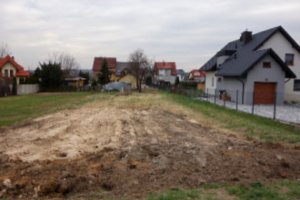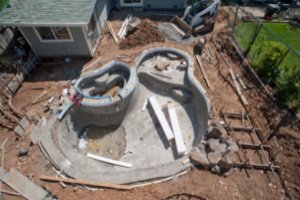Some swimming pools do not get the use and enjoyment that homeowners hoped for when they had their pool installed. At the same time, some homeowners do not feel that their swimming pool is worth the expense and worry associated with pool ownership. When homeowners wish to get rid of an unwanted pool, they have two main options: a full pool removal or a pool fill-in. Both methods have advantages and disadvantages.

A full pool removal is the most complete method as it removes the pool entirely and leaves the yard in a very close approximation to its original condition. However, the cost involved in a full pool removal leaves many homeowners turning to a partial pool removal method known as a pool fill-in. Although this is a more affordable option, it is important to be aware of the problems that can arise when a pool is filled in.
What Is A Pool Fill-In, And What Are The Risks?
In a pool fill-in or partial pool removal, the pool will be drained and then holes will be drilled into the bottom of it. Next, the top portion of the shell of the pool is broken off and the rubble is deposited into the bottom of the pool. The entire pool shell and hole is then filled with filled dirt, rubble and gravel.
In contrast, a full pool removal involves removing every trace of the pool. The entire shell is completely demolished and the parts and pieces are hauled away. Finally, the entire area is filled in with dirt and gravel. This option takes a few days longer than a pool fill-in and the price tag is higher, but many homeowners feel it is worth it because it can help them avoid the common problems with filled-in pools listed below.
The Area Will Be Prone To Sinkage And Swelling

One of the most common problems with a filled-in pool is sinkage, swelling or improper seepage. These issues can cause major problems in the yard, such as sinkholes that put other structures in the yard at risk or pooling underground. It can also endanger people and pets who use the yard due to the risk of tripping or falling.
Working with professionals who know how to perform a fill-in correctly and having a backfill conducted by an engineering technician can reduce the chances of this occurring, but there is always a possibility that these problems could occur any time a pool is not removed from the ground entirely.
Water Retention Could Occur In The Remnants Of The Old Pool
Over time, an old pool might retain water if the drainage is not adequate. This can cause the entire area to become swampy, creating a bog in your yard that is unstable and unsightly. Such a situation would provide the perfect breeding ground for mosquitoes and other types of pests.
This is particularly problematic if it occurs after you have already repurposed the area, as it can damage gardens, turf, and landscaping and require expensive repairs.
You Could Encounter Issues With Local Building Codes
If a partial pool removal is carried out as a DIY project or professionals without the proper qualifications are hired for the job, there is a chance that the work will not be up to code, and this could lead to problems with your local municipality.
Many local governments have established rules outlining how a pool must be removed. In some areas, a fill-in is not permitted under any circumstances; in others, there may be protocols that must be followed when it comes to filling the pool in.
The Land Is Deemed Non-buildable

One of the biggest problems with a pool fill-in is the fact that the land where the pool existed will be considered non-buildable moving forward. This restricts how you can use your own yard, and it can be particularly problematic if your future plans involve erecting a structure or making an addition to your home that extends across the area where the pool was. Sheds and landscaping features, however, are generally acceptable.
With a full pool removal, in contrast, the yard will be left in a condition as though there was never a pool there in the first place. This means that it can be used however you wish as there are no concerns about the integrity of the land.
It Could Deter Potential Buyers
Because the land where the pool existed is deemed non-buildable, you will be required to disclose the fact that you have a filled-in pool to potential buyers when it comes time to sell your home.
Many people who are looking to buy a home will not consider a home with a filled-in pool because it limits how they can use their yard. In addition, buyers who would like to build a pool will first need to dig up and haul away the old shell, making the process more complicated and expensive. For these reasons, having a pool filled in rather than completely removed can cause the value of your property to drop.
Pool Reinstalls After Fill-ins Are Cost Prohibitive

Some people believe that a pool fill-in is a safer choice if they are on the fence about having their pool removed because it will be easier to restore if they change their mind, but that is not the case.
If you fill in your pool and it ends up creating an eyesore or other yard problems or you simply decide you are ready to have a pool once again, it may be possible to reinstall a new pool in the same place that you had a pool fill-in. However, it is important to note that the cost of restoring a pool in a filled-in spot is around the same as installing a new one from scratch, if not more, as the filled-in pool must first be emptied and the debris must be hauled away before the cavity for the new pool can be dug.
Find Out More About Pool Removal In Northern Virginia
If you wish to remove an inground pool and you are not sure whether a full pool removal or a pool fill-in is the right choice, get in touch with the experienced pool removal contractors at Dirt Connections to discuss your budget, timeframe and future plans for your yard. Our team can assess your yard and pool and discuss the pros and cons of the options we recommend so you can make an informed decision.
Summary

Dirt Connections was started with one goal in mind: providing quality residential and commercial construction services to clients on time and on budget. Reach out for more information on how we can support your next project.
For your convenience our estimates are free and by appointment. Call 703-940-9949 for a free estimate today!










































